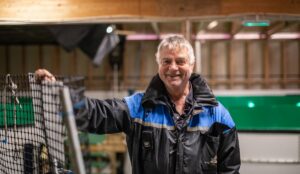They know their plaice

Trials aimed at breeding plaice under farming conditions have proved highly successful, less than two years after getting underway. The results have even surprised the scientists at Norway’s Institute of Marine Research (IMR), which is conducting the experiment.
Plaice may not be quite as fashionable as it was, say, in the 1970s (in the days before farmed salmon became plentiful), but it remains a popular whitefish choice among diners.
This is a fish that can live for up to 50 years. However, they are slow growers, which means wild stocks are under increasing pressure. So around two years ago the IMR decided it was to time to see if they could breed successfully in captivity.
It may surprise some people to learn that the first serious attempt at plaice farming was carried out in 1945, just after the end of the Second World War. Fry production was the main goal at the time and the researchers managed to breed several thousand of them using live shrimp as feed.
It was seen as a major breakthrough, although – until today – nothing much more was done after the 1940s. Back then there was an abundant supply from the sea so it failed to attract much interest from potential backers.
Just over a year ago Fish Farmer magazine reported that trials into plaice farming had resumed, picking up where the 1940s researchers had left off. Now the 21st century IMR team has just announced that their trials have produced very young fish with no disease, few deformities and virtually no serious mortality problems. Using past experience with halibut farming – one of the most difficult species to cultivate – as a basis for the research, they seem to have created the perfect fry.
IMR researcher Anders Magnor-Jensen says the results have been “absolutely fantastic”. He adds: “Now we are left with two family research groups that can give us a brood-stock for the future.”
Magnor-Jensen is now following up the work on larger fish. As he explains: “Biologically, the experiment did present us with a few challenges at the beginning, but we believe plaice may have the potential to become a new (farmed) marine species.”
He said results from data base were not yet clear, but growth was comparable to that of halibut during the first 10 to 12 months. However, it seems that plaice grows faster than halibut in the fry stage.
A new species for fish farming?
Birgitta Norberg, another member of the research team, said at the time of the earlier trials that, thanks in part to previous research, companies are now adding or considering including halibut farming to their commercial operations.
The long-term hope at the Institute is that if results from the current research programme continue to be successful – and the team seems very confident – then plaice will be added to the list of commercially farmed species.
It seems that time cannot come soon enough. Earlier this year Norway, the UK and the EU agreed a new fisheries deal in the North Sea, the main location for the species, which brought a 25% reduction in the plaice quota. Plaice is also found in the Irish Sea and around the coasts of Norway and Iceland.
Mangor-Jensen explained: “We have managed to breed plaice with zero diseases, no mortality and minimal deformations. Fish that survive and grow as well as this means their welfare is good.”
He said that although wild plaice can often reach four or five kilos, they are very heavily fished so are often very small when caught and are usually lucky to reach half a kilo. The hope is that the farmed plaice will be so large they can produce fillets two or three centimetres thick (around one inch).
The next stage now is to find out if this type of flounder fish can grow to a commercial size of around a kilo (2.2lbs) before they are three years old.
With an established market and proven success in raising the fish in captivity, this could prove to be a very interesting species for farmers.”


